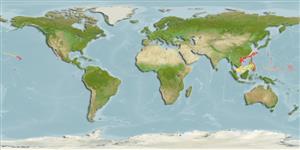Preferred temperature (Ref.
123201): 20 - 27.4, mean 24.5 °C (based on 139 cells).
Phylogenetic diversity index (Ref.
82804): PD
50 = 0.5000 [Uniqueness, from 0.5 = low to 2.0 = high].
Bayesian length-weight: a=0.02291 (0.01133 - 0.04632), b=3.00 (2.83 - 3.17), in cm total length, based on LWR estimates for this Genus-body shape (Ref.
93245).
Trophic level (Ref.
69278): 3.4 ±0.48 se; based on food items.
Widerstandsfähigkeit (Ref.
120179): hoch, Verdopplung der Population dauert weniger als 15 Monate. (Preliminary K or Fecundity.).
Fishing Vulnerability (Ref.
59153): Low vulnerability (10 of 100).
Nutrients (Ref.
124155): Calcium = 100 [51, 156] mg/100g; Iron = 0.843 [0.490, 1.442] mg/100g; Protein = 18.6 [17.4, 19.8] %; Omega3 = 0.145 [0.083, 0.248] g/100g; Selenium = 46.8 [24.6, 87.7] μg/100g; VitaminA = 48.2 [13.3, 177.4] μg/100g; Zinc = 1.4 [0.9, 2.0] mg/100g (wet weight);
